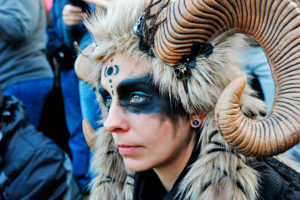On the surface, there was nothing extraordinary about the lives of John and Joan Carrington. He was a carpenter in his late forties with a small estate, mostly eaten up by debts, in the town of Wethersfield in Connecticut. She was his wife and mother to their daughter, Rebecca, and son, John junior, from a previous marriage. But in February 1651, the couple was charged with “familiarity with Satan, the great enemy of God and mankind”, with whose power they had performed “works above the course of nature”. Both were found guilty, sentenced to death and hanged at Hartford.
Today, a stone’s throw away from the site of their execution, the General Assembly of Connecticut is debating a resolution to exonerate 11 women and men convicted of witchcraft in Connecticut between 1647 and 1663. So far, 17 members of the Assembly have backed the resolution, but the bill must yet pass through both chambers. And this is far from certain: there has been more resistance here than in neighbouring Massachusetts, where in 2001 all the Salem “witches” were exonerated by the House of Representatives. The fear in Connecticut, as Republican senator John Kissel put it, is that a precedent would be set; that we would “have to go and redress every perceived wrong in our history”. Similar concerns have been expressed elsewhere. A journalist writing in the Scottish newspaper The Herald worried that pardons vilify accusers and that “we should not judge people for living in the past”.
In some ways, this precedent has already been set. In 2006, Grace Sherwood, a Virginian planter’s wife, was pardoned for allegedly bewitching livestock and crops, and there have been similar rulings in Germany, Switzerland and Catalonia. In March 2022, Scotland’s then First Minister, Nicola Sturgeon, apologised for the persecution of 4,000 people as witches, describing it as “injustice on a colossal scale”. For their part, Scottish campaigners for exonerating witches cited their parliament’s Historical Sexual Offences Act, which in 2018 retrospectively decriminalised sodomy. And the Connecticut campaigners have indicated how inspired they’ve been by developments in Scotland.
Yet, it remains reasonable to ask: how can we exonerate a crime that modern society no longer believes exists? This is a question not just of history, but of jurisprudential ethics. An empirically supported understanding of “the great witch-craze” should inform questions of whether we need to act, and if so what to do. Are we quashing what now seem like unsafe convictions of witchcraft or offering modern pardons for contemporaneously just ones?
If a crime is to be pardoned, we surely need to define the crime. The Connecticut resolution says only that the “witches” were “falsely accused” — but doesn’t say what exactly they were falsely accused of. In Scotland, Sturgeon’s apology stated that so-called witches were “killed because they were poor, different, vulnerable or in many cases just because they were women”. Accused witches often fitted that profile, it’s true, but that wasn’t why they were accused. It’s hard to comprehend this fully but the reason was usually that people believed them to be dangerous agents of the devil. When the people of Wethersfield accused the Carringtons of using satanic power to perform “works above the course of nature”, we should probably assume that they meant it. Nor were the accused exempt from suspecting others of witchcraft: some, even without duress, believed they had become witches, deliberately or simply because witchery was in their blood. After all, the concept was firmly established in law, theology and custom, and then in specific cases impelled by furious emotions, given that these alleged deeds were not just unnatural but prejudicial to the lives and livelihoods of struggling communities.
If we are to exonerate convicted witches, we must ensure that the process is historically rigorous. It undermines the enterprise if, say, we set out to pardon five million people tried for witchcraft when, in fact, we have evidence for only around 100,000. We should know that our ancestors were surprisingly sceptical and wary about pointing the finger, and that across continental Europe about half of trials resulted in acquittal. In England and Connecticut, it was more like 75%, owing to the caution of judges and juries about passing guilty verdicts where the proof for this most secretive crime amounted to little more than hearsay.
It’s also important to realise that most witch trials arose not from hysteria or malice but from historically specific collisions of social and economic crises, polarised religious and political mentalities, and the anxiety and terror fomented by these conditions. When it hanged its first witch in 1647, Windsor, Connecticut, was in the grip of a flu epidemic. This wasn’t blamed on witches, but a five-fold increase in mortality that year made people exceptionally fretful and eager to appease God by purging sinners from their midst. Historians try to understand our ancestors objectively but also on their own terms. Otherwise, we risk flattening out the moral landscape of the pre-modern and the backward export of our own attitudes and values.
We might also ask who the exoneration of witches is for. Is it a public crusade or a private one? The dead don’t care and it’s hard to imagine their ninth-generation descendants feeling the same pain as the Salem families who, in the decade after the witch panic, successfully petitioned to restore their reputations and be awarded compensation. The motion to pardon Connecticut’s “witches” states its purpose thus: “that although these accusations, prosecutions, trials and executions cannot be undone or changed, no disgrace or cause for distress should attach to the heirs of those persons.” These heirs and their supporters are seeking to right wrongs they have come to feel personally by retrospectively identifying with the suffering of their forebears. Appearing before Connecticut’s judiciary committee, Dr Beverly Kahn of Fairfield, a descendant of a “witch” executed there in 1653, declared that her ancestor “acted nobly” and that living relatives “deserve to have the name of Goodwife Knapp cleared”. Commenting on the Connecticut campaign, Sara Jack, whose ninth great-grandmother was accused of witchcraft, has said that these women were “heroes, mothers, grandmothers, sisters, aunts, just like we have today… And we know, for certain, that none of them were covenanting with the devil”. Yet for all their talk of historical trauma, it goes without saying that the exoneration campaign concerns the feelings of the living rather than those of than the dead.
There is another route to a similar, and perhaps better, end. A bronze statue of Grace Sherwood stands on Independence Boulevard in Virginia Beach, and scores of other monuments and plaques can be found around the Western world. Public memorials might seem like a passive form of redress, but at least by remembering the dead in the context of their own times they let them rest in peace, and, like the Cenotaph and other great war memorials, invite quiet contemplation. The Steilneset Memorial in Vardø, Norway, is a dramatic architectural installation, designed (partly by the artist Louise Bourgeois) to commemorate the execution of 91 people there in 1621. But it’s done in such a hauntingly abstract way that we are transported to a place between the past and the present where meaningful memories are created. Perhaps the victims of witch-hunting need imaginative recognition from this and subsequent generations more than they need clean sheets at law.
At the same time, the success of public commemoration projects like Steilneset, which has attracted thousands of visitors, is not an argument against pursuing legal initiatives filed under individual names. Every execution for witchcraft, every life destroyed and family bereaved, was a tragedy, and deserves to be acknowledged as such. John and Joan Carrington of Wethersfield were not walk-ons in a costume drama: they were real people, with hopes and dreams, who had emigrated to America in the 1630s to build new lives, only to become fatally ensnared in a web of adverse circumstances spun from the hostility of their neighbours.
We should be glad that people still care. It’s never a bad thing to shine a light on intolerance and cruelty, however long ago it happened, and formal pardon campaigns are a valid way to achieve this. As Jane Garibay, the State Representative who proposed the Connecticut exoneration resolution, remarked: “To me, that’s an easy thing to do if it gives people peace.”
But in the end, we are better at saying what we want — the exoneration of “witches” — than why. Why witches, and not, say, heretics or traitors guilty of no more than exercising freedoms of conscience, thought and speech? Why not every victim of torture, once standard procedure on the Continent, or the countless minors hanged for petty theft? The answer, I suspect, is straightforward. Memory, like morality, is subjective: a relationship with our ancestors, and a lop-sided one given they have no say. History, though obviously about the past, is produced and consumed in the present. Each generation holds a mirror to modern times, demonstrated most vividly by our choices. The lives of John and Joan Carrington may not have been extraordinary in 1651 — but in 2023, they certainly are.
Disclaimer
Some of the posts we share are controversial and we do not necessarily agree with them in the whole extend. Sometimes we agree with the content or part of it but we do not agree with the narration or language. Nevertheless we find them somehow interesting, valuable and/or informative or we share them, because we strongly believe in freedom of speech, free press and journalism. We strongly encourage you to have a critical approach to all the content, do your own research and analysis to build your own opinion.
We would be glad to have your feedback.
Source: UnHerd Read the original article here: https://unherd.com/





